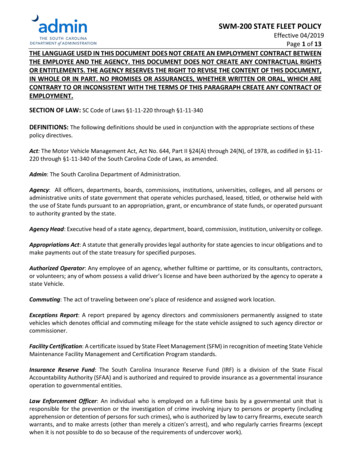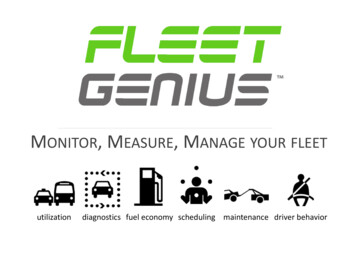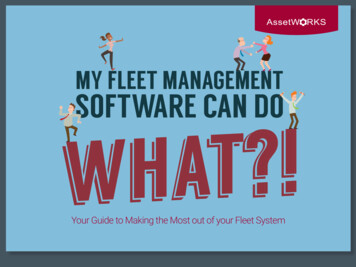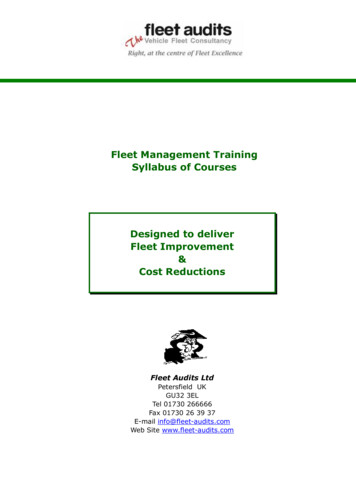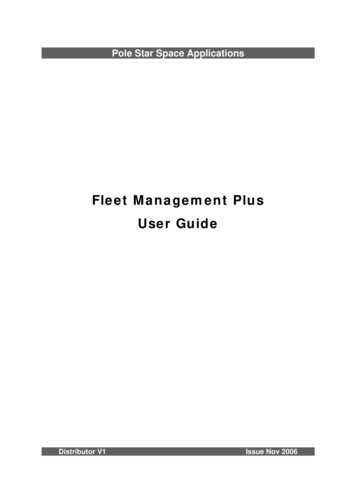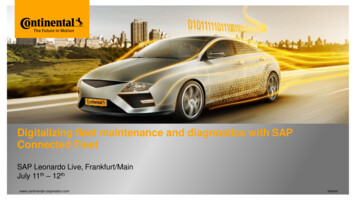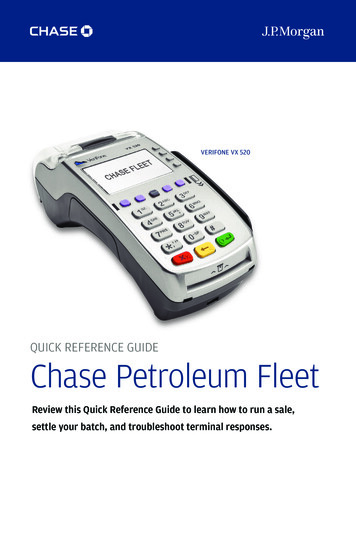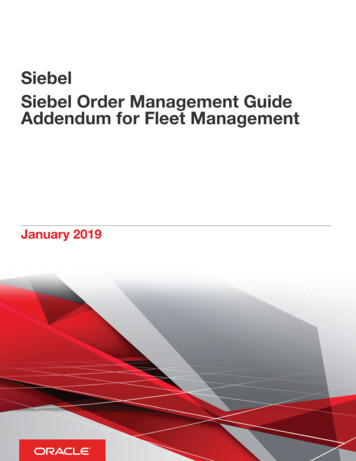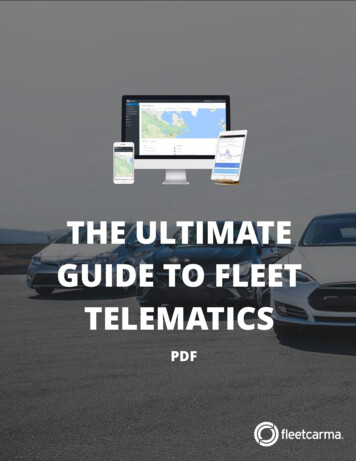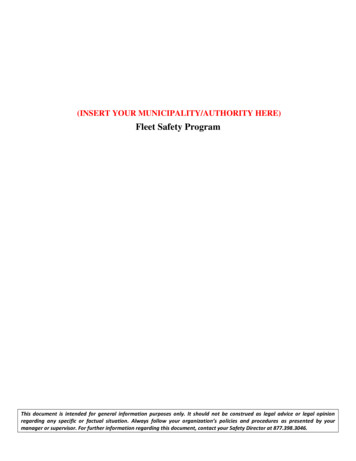
Transcription
(INSERT YOUR MUNICIPALITY/AUTHORITY HERE)Fleet Safety ProgramThis document is intended for general information purposes only. It should not be construed as legal advice or legal opinionregarding any specific or factual situation. Always follow your organization’s policies and procedures as presented by yourmanager or supervisor. For further information regarding this document, contact your Safety Director at 877.398.3046.
Governmental entities often have large fleets of vehicles and can significantly reduce accident rates by following basicmanagement techniques. There are seven management strategies that make a substantial difference in anyorganization’s vehicle safety record. These strategies should be included in a written fleet safety policy that isspecifically adapted to your operation. Specifically:1. Monitor safety performance. Managers communicate their priorities by what they monitor. Managers that are awareof their safety performance are far more likely to make sure the safety program is being conducted properly. Statisticsshould be maintained comparing vehicle accident frequency to previous years and benchmarks. At least quarterly(monthly in the case of large fleet operators) the person responsible for the safety program should prepare a report to topmanagement that summarizes the accident rate and specific accidents. This report should include both occupationalaccidents and vehicle accidents.2. Include all drivers in the safety program. Employers may not be aware of the full extent of their non-owned vehicleexposure. Identify everyone who drives on behalf of the operation, even those individuals who use personal and/or rentedvehicles.3. Screen and select drivers carefully. Establish clear hiring standards and a thorough screening process for anyone whodrives on business.4. Require all personnel to complete a safety orientation and periodic refresher training. Organizations where allworkers are up to date on their safety training average 46% fewer reportable accidents. Large fleet operators often have inhouse training resources while smaller operators depend on contractors or resources provided by their insurer.5. Discuss safety with employees at the start of each shift. Organizations where supervisors and crew leaders discusssafety with their associates each morning average 54% fewer accidents. Managers and supervisors have the responsibilityto make sure each operation is properly planned and that each employee is reminded of the critical safety proceduresrequired for each day’s activities.6. Review all accidents to determine if they were preventable. Fleet operators should establish a formal accidentreview committee that includes representation from senior management. The National Safety Council publishesguidelines for these deliberations. Where applicable, a representative of the bargaining unit should be included in thecommittee.7. Establish a formal plan for vehicle inspection, repair and maintenance. Fleet operators should develop apreventative maintenance program for vehicles and equipment that includes a pre-trip inspection to identifydeficiencies and preventative maintenance based on manufacturers’ recommendations that is completed and documentedby qualified persons.Page 2
Table of ContentsPurpose. 4Scope . 4Program Responsibilities . 4Driver Selection . 4Authorized Vehicle Use . 5Vehicle Maintenance. 5Driver Safety Rules . 5Cell Phones and Other Distractions . 5Seat Belts . 5Fatigued Driving & Driving Under the Influence . 6Severe Weather . 6Radar Detectors . 6Glass. 6Towing . 6Traffic Violations and Citations . 6Periodic Program Review . 7Record Retention . 7Revision History . 7Appendix A – Annual Evaluation Report . 8Appendix B – Driver List. 9Appendix C – Vehicle Self-Inspection Report. 10Appendix D – Vehicle Accident Report . 11Appendix E – Training Record/Certification for Fleet Safety Program . 14Page 3
PurposeThe purpose of this Fleet Safety Program is to detail the policies and procedures to minimize the frequency and severity ofvehicle accidents. Any deviations from this program must be immediately brought to the attention of .ScopeThis policy applies to: All drivers of owned, leased, rented or borrowed vehicles. All drivers of non-owned vehicles while being operated on (INSERT YOUR MUNICIPALITY/ AUTHORITYHERE) business.(Title) is responsible for the program’s implementation, managementand recordkeeping requirements.Program Responsibilities(Title) is responsible for oversight of this program. All driverselection, vehicle maintenance, training and other program components will be coordinated under their direction.Additional duties include: Evaluates applicants to determine if they are eligible to drive our vehicles or other vehicles on Municipal/UtilitybusinessAuthorizes those persons who are allowed to operate vehiclesOversees annual review of MVRsEnsures vehicles are maintained in safe conditionDevelops and enforces fleet safety rules and policiesDefine policy regarding use of personal vehicle on municipal businessInvestigates all vehicle accidents and recommends any necessary corrective actionsEnsures that a supervisor’s incident report is completed and submittedCoordinates driver training programsAnnually reviews this written program and makes any changes needed. Documents the annual review on theproper forms (found in Appendix A) and submits the report to upper managementDriver Selection(INSERT YOUR MUNICIPALITY/AUTHORITY HERE) will check the driving history of all applicants through theuse of a Motor Vehicle Record (MVR) before they are granted driving privileges. An updated MVR for all approveddrivers will be obtained and reviewed annually thereafter. A driver list is maintained and updated annually, and includesthe date of the last MVR obtained for each driver. The approved drivers' list will be recorded on the proper form found inAppendix B and maintained by the Program Administrator.Employees will be prohibited from operating vehicles on Municipal/Utility business under any of the followingconditions: Employee does not have a valid driver’s license, or the license has been suspended or revoked Employee does not have at least one year of verifiable driving experience.Page 4
Employee’s MVR indicates more than three moving violations and/or preventable accidents in the past three years,or more than 2 moving violations and/or preventable accidents within the most recent year. Suggested modifyto reflect your current policy Employee’s MVR indicates any one of the following major violations within the past three years:ooooo Driving under the influenceReckless drivingVehicular manslaughter/homicideLeaving the scene of an accidentOperating with a suspended or revoked license enter any additional driver selection criteria used by your organization Authorized Vehicle Use(Title) determines who is authorized to operate vehicles onMunicipal/Utility business. No employee or nonemployee (for example, an employee’s spouse or child) is allowed tooperate a Municipal/Utility vehicle, or their own vehicle on Municipal/Utility business, unless the Program Administratorhas authorized that person to drive. Before any non-employee is permitted to use a Municipal/Utility vehicle, he or shemust meet the same qualifications as employees. Use of Municipal/Utility vehicles by employees and nonemployeesunder the age of 18 is prohibited.Vehicle MaintenanceRegular inspections and maintenance will be completed on all Municipal/Utility owned and operated vehicles per themanufacturer’s recommendations. If during an inspection any of the items are found deficient, the vehicle will beremoved from service until it can be repaired or replaced. All problems must be promptly reported to the ProgramAdministrator. Each driver will inspect the vehicle before each use. The inspection will consist of all items listed in theVehicle Self-Inspection Report (form located in Appendix C).Driver Safety RulesAll motor vehicle operators must obey all state laws and posted signs when operating vehicles. In addition, the followingrules must be followed at all times.Cell Phones and Other DistractionsThe use of handheld or hands-free cell phones, or other devices that take attention away from the driving task, areprohibited when driving Municipal/Utility vehicles. Passengers may use devices only if the use will not be distracting tothe driver. Cell phone calls should be made prior to or at the completion of a trip. If a call must be made during a trip,drivers must pull into a safe location and stop before making the call. If the driver receives an incoming call while driving,they must allow the call to go to voicemail and return the call when stopped in a safe location.Police – Officers on duty will restrict Phone use to department related calls or calls directly pertaining to law enforcementissues.Eating while driving is prohibited. Non-alcoholic drinks may be consumed with great discretion and only in situationswhere driving hazards are minimal (i.e., not in traffic, through road construction, etc.)Seat BeltsPage 5
Seat belts must be properly worn by all drivers and passengers while the vehicle is in operation. Children beingtransported must remain properly secured in a child safety seat or booster seat according to state law.Fatigued Driving & Driving Under the InfluenceDrivers will not operate a motor vehicle at any time when his/her ability is impaired, affected or influenced by alcohol,illegal drugs, medication, illness, fatigue or injury.It is the employee’s responsibility to notify his/her supervisor of their inability to drive a vehicle.Severe WeatherExtreme caution must be exercised when driving in severe weather conditions. If a driver has any doubt about the safetyof travel, they must contact their supervisor for guidance.Radar DetectorsThe use of radar detectors or any other device with the purpose of detecting or interfering with police radar is prohibited.Glass & MirrorsAll damaged glass should be reported immediately. To reduce windshield damage, and maintain good visibility, driverswill: Keep a safe distance between vehicles, especially on gravel roadsUse clean, greaseless, dry cloths to wipe the windshieldReplace worn wiper blades as soon as they begin to streakUse plastic or rubber ice scrapers, never metalKeep all glass & mirrors free of dirt, mud and snowTowingOnly vehicles specifically approved for towing may be used to tow trailers of any size or type. Enter any additional driver safety rules used by your organization Traffic Violations and CitationsDrivers are responsible for all citations received. Traffic citations must be reported to (Title)as soon as possible who will review the driving privileges of any employee charged with aserious offense. Disciplinary action may include warnings, probation or suspension of driving privileges. For those jobsthat require operation of a Municipal/Utility owned vehicle, loss of driving privileges may result in termination.Vehicle Accident InvestigationVehicle accident investigations are handled internally and may utilize external documents such as police reports. Vehicleaccident reports are to be filled out by the driver and returned to(Title)as soon as reasonably possible.(Title) willdetermine accident preventability and the proper course of disciplinary action that may be necessary. This person will alsodetermine if additional training is needed to prevent similar accidents from occurring in the future. Trends in types ofaccidents or multiple accidents by the same driver will receive additional scrutiny, as they may signal the need foradditional training or changes to driver selection procedures.If you are involved in an accident, perform the following steps:Page 6
Stop your vehicle and protect the scene. You do not want a secondary accident to occur.Call for medical assistance and assist any injured people, if necessary.Call the police and (Title) or a supervisor as soon as possible.Locate any witnesses and get important information from them. If possible, get names, addresses and phonenumbers.Exchange pertinent information with other drivers.Take photos of the accident.Fill out a vehicle accident report form and send it to the Program Administrator (forms are in Appendix D).When in an accident, drivers must: Never admit fault or apologize. Apologies could be interpreted as an admission of fault.Never argue with other drivers or witnesses.Never argue with the police.Never make a statement to the media. Refer them to (Title) .Never discuss details of the incident with anyone except a representative of (INSERT YOURMUNICIPALITY/AUTHORITY HERE) or the police.Report every accident no matter how small to the (Title) .Vehicle Accident Report forms must be kept in each vehicle for use after an accident. If the vehicle you are driving doesnot have a Vehicle Accident Report form in it, contact the Program Administrator.Driver TrainingUpon initial assignment of driving privileges, each driver will be required to attend a training session that outlines therules and procedures in our Fleet Safety Program. Ongoing training will be offered to all drivers, at least annually, toensure they are kept up-to-date with defensive driving techniques and changes to the policies and program. Driver ride-alongs may also be conducted upon initial hire and periodically thereafter as deemed appropriate by(Title) . Training and retraining will be documented (Training Record/Certification forms arein (Appendix E).Periodic Program ReviewAt least annually, the Program Administrator will conduct a program review to assess the progress and success of theFleet Safety Program. The review will consider the following: Evaluation of all training programs and recordsThe frequency and severity of vehicle accidents during the previous yearThe need for changes to the Fleet Safety Program, based on evaluation of the program and resultsThe need for changes to the driver selection/disqualification criteriaRecord RetentionAll records will be retained for XX years. Refer to Public record retention requirements Revision History Revision XX – March 2012 Page 7
Appendix A – Annual Evaluation ReportDate of Evaluation:Written Program Reviewed:Evaluated by (list all present):Yes NoComments on Written Program:Do vehicle accident records indicate a need for additional employee training on the program? YesThe following content was added/modified/removed from the written program:Comments:Page 8No
Appendix B – Driver ListThose listed below have been authorized to operate motor vehicles on Municipal/Utility business and have receivedinstruction regarding the (INSERT YOUR MUNICIPALITY/AUTHORITY HERE) Fleet Safety Program.Employee NameDate of Last MVR CheckPage 9
Appendix C – Vehicle Self-Inspection ReportPage 10
Appendix D – Vehicle Accident ReportTO PASSENGERS AND OTHERSMy employer requires that I report details of all accidents. If you witnessed this one, pleaseassist me by writing your name below. Write a brief description of your version of theaccident on the reverse side, even if you consider me at fault.NameHome AddressTel.Business AddressTel.DatePage 11
Page 12
Page 13
Appendix E – Training Record/Certification for Fleet Safety ProgramThis is to certify that the undersigned received training inMUNICIPALITY/AUTHORITY HERE) Fleet Safety Program.Print Nameaccordancewith the(INSERTYOURSign NamePrint Instructor’s NameInstructor's SignatureInstructor’s TitleDate of TrainingThis document is intended for general information purposes only. It should not be construed as legal advice or legal opinionregarding any specific or factual situation. Always follow your organization’s policies and procedures as presented by yourmanager or supervisor. For further information regarding this document, contact your Safety Director at 877.398.3046.
Establish a formal plan for vehicle inspection, repair and maintenance. Fleet operators should develop a preventative maintenance program for vehicles and equipment that includes a pre-trip inspection to identify deficiencies and preventative maintenance based on manufacturers' recommendations that is completed and documented .
